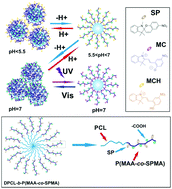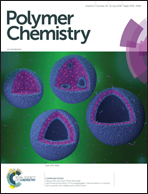Light- and pH-dually responsive dendrimer-star copolymer containing spiropyran groups: synthesis, self-assembly and controlled drug release†
Abstract
Amphiphilic dendrimer-star copolymer poly(ε-caprolactone)-block-poly(methacrylic acid-co-spiropyran methacrylate) (DPCL-b-P(MAA-co-SPMA)) was synthesized by the combination of ring-opening polymerization (ROP), atom transfer radical polymerization (ATRP), acidolysis and DCC reactions. The copolymer could self-assemble into spherical micelles in water. In the copolymer, spiropyran (SP) groups displayed light- and pH-dually responsive properties through UV light irradiation and altering the pH values of micelle solutions. Upon UV light irradiation or at low pH, the hydrophobic spiropyran (SP) isomerized to the hydrophilic merocyanine (MC) or merocyanine H+ (MCH). Besides, the PMAA segments also presented pH-responsive properties. Therefore, the morphologies of the micelles could be adjusted by UV/Vis light irradiation or by altering the pH values. The copolymer micelles were used as the drug delivery system for the controlled release of the anticancer drug doxorubicin (DOX). The cytotoxicity investigation showed that the copolymer micelles possessed good biocompatibility. As a result, the dendrimer-star copolymer is expected to be used as an intelligent carrier of hydrophobic drugs.



 Please wait while we load your content...
Please wait while we load your content...